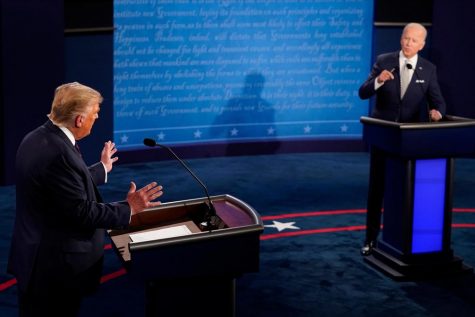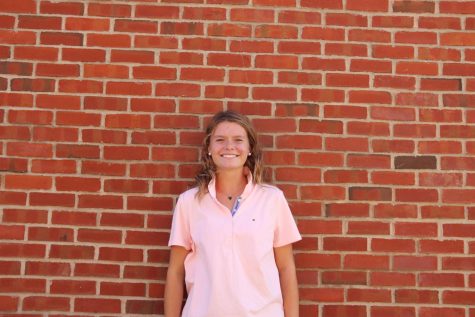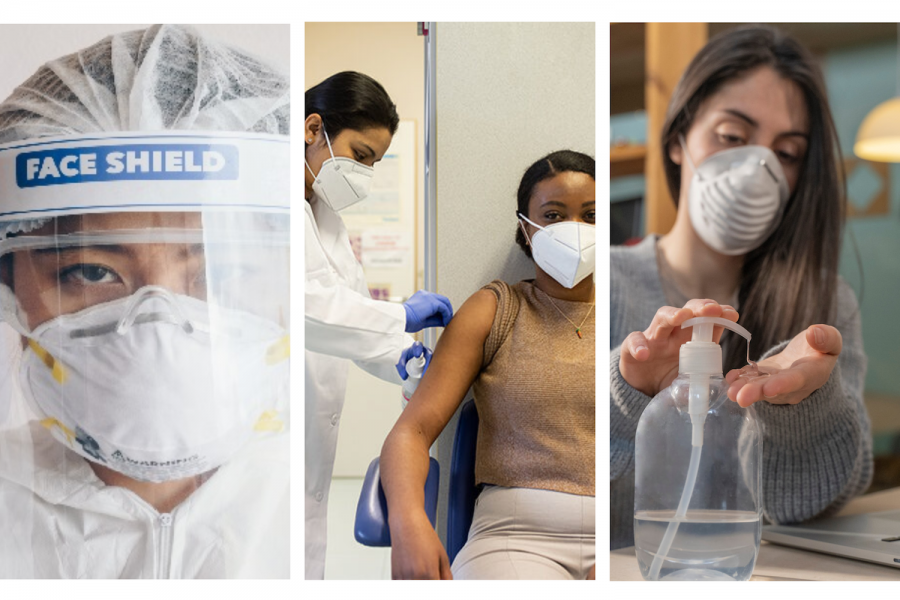An unprecedented year teaches resilience
The COVID-19 pandemic prompted a year in lockdown, globally upending normalcy.
A new strain of coronavirus has run rampant across the globe for the past 15 months following its confirmation December 31, 2019. The World Health Organization made a statement March 11, 2020 that declared the outbreak of the novel virus a pandemic, officially marking the start of a worldwide lockdown. Within a year, COVID-19 restrictions introduced a multitude of lasting changes that have impacted education, politics, mental health, and economics on a global level.
Public health regulations led to widespread school shutdowns, preventing in-person learning for 1.2 billion students in 186 countries. As a result, teachers all over the world shifted their physical classrooms into virtual Zoom rooms, allowing learning to continue from home. However, the transition to online school had negative effects. Twenty-five percent of children do not have the technological means to keep up with their classmates during remote learning. Known as the “homework gap,” this results in poor mastery of topics taught in online classes, eventually causing students to fall behind their peers due to their lack of access to technology.

COVID-19 exacerbated income inequality among vulnerable socioeconomic groups. Fifteen percent of adults have lost their job as a result of the pandemic. Low-income families are disproportionately affected by coronavirus-induced unemployment, according to pewresearch.org. The global price of food rose 20 percent from January 2020, resulting in the inflation of retail prices, that, coupled with reduced incomes, led to increased food insecurity. The World Food Programme (WFP) approximates that 149 million people worldwide experienced food shortages in 2019, and this number met a projection of 279 million in 2020 as a consequence of COVID-19.
The presence of COVID-19 also made its way into politics. In October 2020, the University of Texas at Dallas administered a national survey two weeks prior to the presidential election. Sixty-two percent of 2,500 responses labeled COVID-19 as one of the top three issues currently harming the country the most, and 39 percent indicated the coronavirus pandemic as the single most important subject at the moment. Former President Donald J. Trump faced an adverse reaction from voters during the 2020 election, as the survey revealed that 67 percent of responses demonstrated a trend of disapproval regarding his performance throughout the coronavirus pandemic, according to theconversation.org.
The mention of COVID-19 within political debates has sparked an ongoing conflict regarding the role of masks in conjunction with the severity of the pandemic. Masks and other facial coverings have proven their effectiveness in preventing the transmission of COVID-19, but some members of the population have turned the use of masks or other facial coverings into a political debate. Research shows that, despite what some individuals may personally believe, wearing a mask or facial covering drastically reduces the spread of the coronavirus, according to cdc.org.
Mr. Andrew Cuomo, State Governor of New York, introduced the mandates regarding the usage of masks and facial coverings in April 2020. Mr. Cuomo issued an executive order requiring all people in New York to wear a mask or face covering when out in public and in situations where social distancing is not possible, according to governor.ny.gov. In a daily briefing, Mr. Cuomo raised a question that is still relevant, almost one year later.
“Stopping the spread is everything,” Mr. Cuomo said, according to The New York Times. “How can you not wear a mask when you’re going to come close to a person?”
The psychological effects of the coronavirus pandemic are also present, as four in ten adults reported symptoms of anxiety and depression in the past year alone. This number is an increase from 2019, as only one in ten adults previously admitted to symptoms of anxiety and depression when asked the same question, according to kff.org. Overall, 56 percent of young adults between the ages of 18 and 24 disclosed symptoms of both anxiety and depressive disorder during the pandemic. The coronavirus pandemic seems to heighten rates of anxiety and depressive disorder in adults of all ages who suffered from poor general health before lockdown, according to kff.org.
Dr. Melissa Otero, School Psychologist and Lead Wellness Strand of the Department of Student Support Services, understands the psychological impacts of COVID-19 on pre-teens and adolescents.
“There has been a significant mental health crisis as a result of the pandemic due to a number of factors, including increased isolation, anxiety around getting sick, job loss, school disruptions, and loss of loved ones,” Dr. Otero said. “Just one of these stressors would be enough to trigger significant anxiety and depression, but many people have been experiencing numerous stressors at the same time for a prolonged period of time. Mental health services across the country have largely gone virtual. There are of course pros and cons to telehealth, but one of the pros is that it has increased access to services. The challenge is that mental health practitioners have been overwhelmed by the need.”
A social outcome of the coronavirus pandemic is an upsurge in anti-Asian sentiments. COVID-19 originated in Wuhan, China, and as the virus spread across the globe to the United States, the Asian population faced blame for its existence. Fear of the unknown virus in coexistence with pre-existing racism against Asian-Americans led to a rise in anti-Asian American hate crimes. Mr. Trump used the term “Chinese virus” in a tweet, causing an increase in anti-Asian tweets and hashtags. Mr. Robert Redfield, the former director for the Center for Disease Control and Prevention (CDC), acknowledged and criticized Mr. Trump’s racist labeling of the virus, according to The Washington Post.

College admissions for the 2020-2021 academic year have also met unforeseen obstacles. As a result of quarantine regulations, at least 1 million high school students in the class of 2021 were not able to sit for their SAT or ACT exams, according to edsurge.com. Consequently, colleges waived their standardized test score requirements, allowing for a more holistic approach to analyzing applications. Ms. Tovia Smith, a national correspondent for National Public Radio (NPR), reflected on this decision in an article about how the pandemic has affected college admissions.
“By most accounts, students’ recommendations and their essays will get a closer read,” Ms. Smith said, according to npr.org. “And admissions officers will pore over transcripts looking for academic rigor and any patterns that help bear out a student’s academic profile. They’ll be working overtime trying to triangulate each piece of the application they have, to make up for what they don’t.
This decision to remain test-optional has extended to applicants in the 2021-2022 college admissions cycle. In addition, the University of California college system intends to phase out all use of standardized testing scores by the year 2025. This decision could potentially upend the multi-billion dollar testing industry, according to fortune.com.
Nine months after the declaration of a national emergency, the rollout of the first COVID-19 vaccine occurred in December 2020. The companies Pfizer-BioNTech, Moderna, and Johnson & Johnson each produced a separate vaccine. The U.S. Food and Drug Administration (FDA) issued emergency use authorizations for all three vaccines, and medical professionals recommended them for use in the United States. The vaccines help develop immunity to COVID-19 without contracting the illness, according to cdc.gov.
Dr. Kristina Gremski, Chair of the Upper School Science Department and Upper School Science Teacher, discussed the development of the COVID-19 vaccine, a scientific breakthrough that utilizes mRNA genetic materials to prevent getting the virus a second time.
“Traditional vaccines typically consist of a weakened or inactivated virus, which can’t cause disease symptoms,” Dr. Gremski said. “The vaccines stimulate our immune system to develop defenses against that specific virus so that our bodies can quickly defeat the virus if we’re exposed to it in the future. The new mRNA vaccines consist of injecting our muscle cells with a molecule called mRNA. The specific mRNA used in this vaccine has instructions to make one particular viral protein. SARS-CoV-2 has proteins called spike proteins, which stick out of the virus. The mRNA in the new vaccines instruct our cells to make these viral spike proteins. It can’t make the full virus, so you can’t get sick from it. However, our immune system will recognize the spike proteins as something foreign and will initiate an immune response. If a person then gets infected with the actual virus, they should theoretically already have specialized immune cells that can defeat the virus quickly.”
Featured Image by Natalie Dosmond ’21

Libby is ecstatic to be back in the Newsroom for another engaging school year. She cannot wait to share her passion for journalism with the staff writers...


